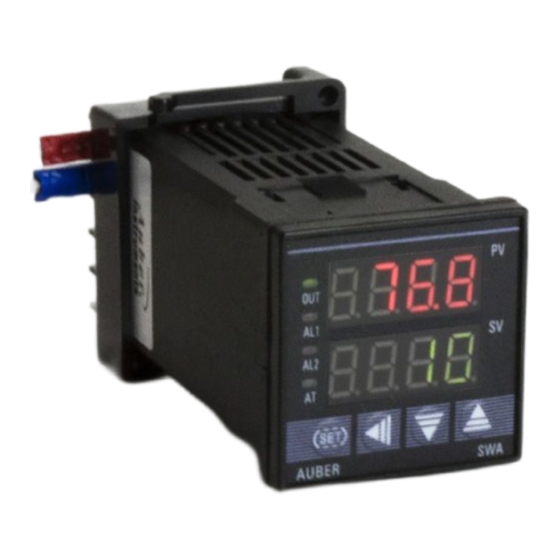Auber Instruments SWA-2441A 사용 설명서
{카테고리_이름} Auber Instruments SWA-2441A에 대한 사용 설명서을 온라인으로 검색하거나 PDF를 다운로드하세요. Auber Instruments SWA-2441A 6 페이지.

AUBER INSTRUMENTS
Instruction Manual
SWA-2441A PID TEMPERATURE CONTROLLER INSTRUCTION MANUAL
1. Caution
• This controller is intended to control equipment under normal operating
conditions. If failure or malfunction of the controller may lead to abnormal
operating conditions that may result in personal injury or damage to the
equipment or other property, devices (limit or safety controls) or systems
(alarm or supervisory) intended to warn of or protect against failure or
malfunction of the controller must be incorporated into and maintained as
part of the control system.
• Installing the rubber gasket supplied will protect the controller front panel
from dust and water splash (IP54 rating). Additional protection is needed for
higher IP rating.
• This controller carries a 90-day limited warranty. This warranty is limited to
the controller only.
2. Specifications
Table 1. Specifications
Input Type
Thermocouple: K, E, J, T, S. RTD: Pt100, Cu50
K (-20~2370ºF), S (-20~2912ºF), T (-190~750ºF),
Input Range
E (-20~1290ºF), J (-20~1651ºF), Pt100 (-200~1100ºF)
Cu50 (-56~302)
Two lines, four digits. Temperature & time or
Display
temperature & set temperature.
Display
Temperature: 1° C/° F and 0.1° C/ ° F
Resolution
Time: 1 second/ minute.
Temperature: ± 0.5% of full input range.
Accuracy
Time: 1 second.
Temperature: PID, manual control, on-off,
Control Mode
Time: timed PID, timed on-off, independent timer
Timer Mode
Single delay, double delay, count up, count down
Timer Range
1 - 9999 seconds or minutes
Anti-Short Cycle
Delay Timer
1 - 200 minutes
Range
Relay output: N.O. contacts. 10 A at 120 VAC, 10 A at
Control Output
240 VAC, 10 A at 30 VDC
Timer alarm, process high/low alarm, deviation
Alarm
high/low alarm
Relay: 3 A at 240 VAC, 5 A at 120 VAC, or 3 A at 30
Alarm Output
VDC
Power Supply
90 ~ 265 VAC, 50 ~ 6 0Hz
Dimension
1.89" x 1.89" x 4.25", or 48 x 48 x 108 mm (1/16 DIN)
Insertion Depth
From front panel: 3.95" or 100 mm
Panel Cutout
1.75" x 1.75" or 44.5 x 44.5 mm
2019.01
Version 1.0 (Jan, 2019)
3. Terminal Assignment
Note: Use a wire or a N.C. switch to jump pin 11 and 12 together to enable the
timer.
3.1 Sensor Connection
Please refer to table 3 for the input sensor type (Sn) setting codes. The initial
setting for input is for a type K thermocouple. Set Sn to the correct sensor code if
another type of sensor is used.
3.1.1 Thermocouple
The thermocouple should be connected to terminals 4 and 5. Make sure that the
polarity is correct. There are two commonly used color codes for the K type
thermocouple. US color code uses yellow (positive) and red (negative). Imported
DIN color code uses red (positive) and green/blue (negative). The temperature
reading will decrease as temperature increases if the connection is reversed.
When using ungrounded thermocouple that is in touch with a large conductive
subject, the electromagnetic field picked up by the sensor tip might be too large
for the controller to handle, the temperature display will change erratically. In that
case, connecting the shield of thermocouple to terminal 5 (circuit ground of the
controller) might solve the problem. Another option is to connect the conductive
subject to terminal 5.
3.1.2 RTD sensor
For a three-wire RTD with standard DIN color code, the two red wires should be
connected to the terminals 4 and 5. The white wire should be connected to
terminal 3. For a two-wire RTD, the wires should be connected to terminals 3 and
4. Jump a wire between terminals 4 and 5. Set controller input type Sn to Pt.
3.2 Power to the Controller
The power cables should be connected to terminals 6 and 7. Polarity does not
matter. It can be powered by 120V or 240VAC power source. Neither a
transformer nor jumper is needed to wire it up. For the sake of consistency with
the wiring example described later, we suggest you connect the neutral wire to
terminal 6 and hot to 7.
3.2.1 Timer Reset terminals
Terminals 11 and 12 are for connecting a reset switch. If you need to start the
timer after controller is powered up, you should short these two terminals
together with a jumper wire. To use the reset function, these terminals should be
connected to a switch. Open the contact of the switch will rest the timer. Close
the contact of the switch will start the timer. Some applications may need a N.O.
WWW.AUBERINS.COM
Figure 1. Wiring diagram
P1/6
